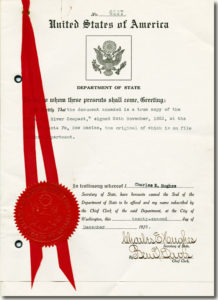Stephen Sturgeon, a Utah State University historian, wrote a legislative biography of Western Slope congressman Wayne Aspinall, called “The Politics of Western Water.” He laments that Colorado controls less than half of its water, because of legal requirements. “Colorado has lost nearly every court battle it has fought to keep exclusive control of its water supply,” he writes. “As a result, Colorado has been forced to enter into interstate water compacts with all of its neighbors except Oklahoma, plus all the states in the Colorado and Rio Grande river basins.”
Though they already have over half of Colorado’s water, the other states are never satisfied, always wanting to “renegotiate.” Perhaps Colorado loses so many water battles with other states because it has fought on the wrong ground. Consider how those interstate compacts work in the case of the Colorado River. In the 1920s its water was divided between Upper and Lower Basins, half the water allocated to each. The allocations were based on an annual flow of about 16.4 million acre-feet (MAF), the historical average for well over a century. The Lower Basin states of California, Nevada, and Arizona were allocated 7.5 MAF of water, as were the Upper Basin states of Colorado, Wyoming, Utah, and New Mexico (the remainder to Mexico under an international treaty).
California convinced Congress to distribute the Lower Basin’s half by population: 4.4 MAF for California, 2.8 MAF for Arizona, and 0.3 MAF for Nevada. Arizona only agreed when promised construction of the Central Arizona Project (CAP), to divert its share to Phoenix. Then, California fought construction of the CAP, and spent years in court claiming Arizona had abandoned its share.The Upper Basin states agreed on distribution of their half in 1948, allocating percentages of the annual flow, not fixed amounts. Colorado got 51.75 percent (of the Upper Basin half), Utah 23, Wyoming 14, and New Mexico 11.25.
For decades, California used its share, and the unused portions of the other states’ shares. It also opposed virtually every attempt by the other states to develop their entitlements, including opposition to virtually every water project ever built or proposed in Colorado. Several reservoirs were built anyway, enabling Colorado to utilize about three-fourths of its share, including Blue Mesa, Ridgway, Animas-La Plata, Ruedi, Dillon, Granby, and others. Other proposed water projects were never built for various reasons, and California opposed them all – while using Colorado’s unused water. And the Lower Basin states continually whine that the compact should be renegotiated, so they can get more water for growing populations. Colorado has always fought re-opening that discussion, knowing it is badly outnumbered.
Fast-forward to 2020, and this bit of history is especially frustrating for Colorado. Today the major issue involving these interstate compacts is that they allocate more water than is really there. Hydrologists today say the actual flow of the River is not 16.4 MAF, but perhaps 13. Debate rages about how that affects administration of the river, how to operate the main reservoirs (Meade and Powell), and how to deal with a “call,” or demand, from the Lower Basin during drought years. Every time the issue is raised, though, leaders assume Colorado will just have to “conserve” more (i.e. use less). Some of its own water leaders oppose new water storage projects, saying there just isn’t any more water to develop – entitlement or not.
Yet through all of these debates, rarely has any Colorado water leader seriously suggested equally adjusting all the allocations, based on the lower quantity of water. Under current law, the Lower Basin is entitled to its 7.5 MAF, in times of surplus or drought. California gets its 4.4 MAF, whether or not there is enough water for the other states. So, if there is not enough water for the entire Lower Basin allocation, Colorado loses. Colorado is the only state not using its entire share, so any surplus water used in the Lower Basin is, by definition, Colorado’s water.
Glenn Saunders, who practiced water law for 60 years in Colorado, argued in his retirement “memoir” that the Compact could be rewritten without much difficulty, and without a protracted political battle – IF the percentages stayed the same, with every state’s entitlement adjusted to reflect the actual flow. Colorado already uses only three-fourths of its share, so it would not change this State’s situation much. But it would make the Lower Basin share 6.5 MAF, not 7.5, and California would get 3.8, not 4.4.
I’m sure the other states would never agree to such a solution, but it is the ethical “high ground” for Colorado. Colorado could acknowledge the Compact’s inherent flaw (over-estimation of the flow), while still insisting on the essential fairness of the allocations. The next time others raise the issue, as they inevitably will, that should be the official policy of Colorado, and the entire Upper Basin. I suspect that would be a very short meeting. But it would be interesting to see the Lower Basin states scramble to defend the existing compact for a change. That might happen if Colorado chooses the “high ground” in the ongoing water wars.
An edited version of this column first appeared in the Grand Junction Daily Sentinel July 31, 2020.





Comments on this entry are closed.